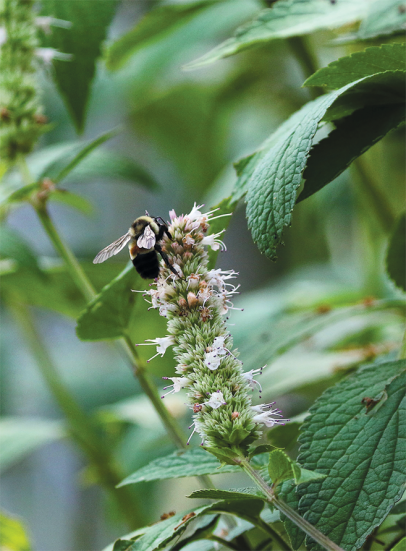Bee Native
When you think of the word “bee,” you probably think about a fuzzy, fat-bodied creature buzzing about from plant to plant in your backyard. These creatures are not honey bees, but a group of native species referred to as bumble bees.
Bumble bees are very important to our landscape, and provide humans a great service by pollinating native plants and agricultural crops. Like honey bees, bumble bees live in colonies led by a single female, called a queen. The queen overwinters just below the ground, usually under leaf litter, grass or other cover. The queen emerges in the spring, and begins feeding on the nectar of early spring flowers while she looks for a nest site, where she will lay eggs that will become workers for the colony. A bumble bee colony can be as large as 50 individuals by summer. In the late summer and fall, young female queens leave the colony to find overwintering sites and wait for spring.
Unfortunately, bumble bees in Ohio and across the United States have been on the decline in recent decades.
Several species of bumble bees are utilized for the pollination of crops in greenhouses. But when those bees escape, they interact with wild bumble bees, and can pass on diseases or pests to which native populations have no defense.
Land development has also reduced bumble bee numbers by replacing areas of native plants with housing or industry. Typically, as a consequence of development, pesticide use to protect landscaping kills most remaining insects indiscriminately, including native bee species.
Finally, changes in climate can influence when certain flowers bloom, which can be disastrous for bees that depend on consist food sources from early spring to late fall.
As a direct result of the threats bees face, in 2017 the rusty patched bumble bee became the first bee listed as state and federally endangered, a result of dramatic declines of this species throughout its range. According to the U.S. Fish and Wildlife Service, populations have declined 87% in the past 20 years. Historically the bees are found in the eastern United States (including Ohio) and southern Canada, and a lack of confirmed sightings could mean the species is in danger of becoming extinct. Rusty patched bumble bees have only been confirmed in Ohio at a few locations since 2000.
But you can help. This spring and summer, look for bees, especially the rusty patched bumble bee, which can be identified by a reddish patch that is located about halfway down its abdomen. If you can, consider taking a bee photo and submitting it to the Ohio Bee Atlas at go.osu.edu/ohiobeeatlas. This will help researchers get a better idea of bee distribution across Ohio.
Ways to Help Our Bees
• Provide native flowers during all growing seasons (spring, summer and fall).
• To help overwintering and nesting queens, leave an area of your yard unmowed and allow leaves to remain on the ground. If this not an option, you can create a small composting area in the corner of your yard to leave grass clippings, leaves or other landscape material for insects to use.
• Avoid using pesticides. Use nature-friendly products in spot treatments that will rid you of pests but keep the bees and other pollinators around. Diatomaceous earth, salt sprays and soap water sprays (using pure, natural liquid soaps) can all be used.





